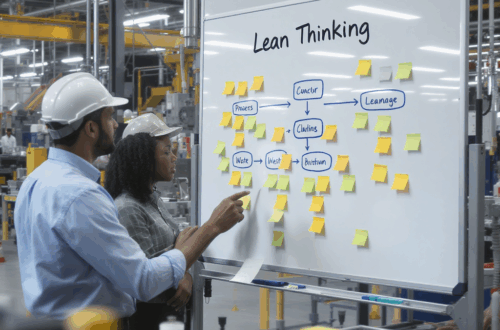Lean thinking has been built on the assumption that you first must develop a stable value stream before you try to improve the processes. There was a time when developing a stable value stream was a possibility, but in today’s world of disruption, caused by medical, political, sustainable or climate agendas, the likelihood of seeing a stable supply chain is a distant vision. We must focus, not on stability but on agility. Agility to be able to adapt to different environments that we are working in. Every part of our strategy, mission, product, process, organisation and culture must adopt agility to be able to react to the known future and the unknown future.
In the recent pandemic, many companies quickly recognised that agility with the availability of raw materials was essential. Many organisations built businesses based on the assumption that a cheap supply of raw materials would be available from the far east. This assumption has proven to be very simplistic and narrow-minded. ‘Cheap’ is not a good strategy if you cannot get access to materials. Many businesses will now look for alternative and multiple sources of materials. Processes to certify alternative sources will also have to be optimised and put in place. Moving to ‘Just in Case’ as opposed to ‘Just in Time’ may not be considered a poor strategy in the short term.
Agility also refers to products. The motor industry in the US is struggling today as it has millions of cars partially manufactured and cannot be completed due to the unavailability of semiconductors. There may be a desire for electronic technology but ultimately may not be a need for such technology. You would imagine that there would be a strong market today for a new car, that is safe, reliable, sustainable, repairable, functional and does not need to be upgraded every month with the latest technology and software. Such simplicity is becoming very attractive as it allows the customer to maintain control of the elements that are important to them. Technology is marketing a desire for unrequired features and upgrades that add little value. The role of technology should be to support the value of the product, rather than the product being a marketing tool to subscribe to the latest technology.
Finally, agility applies to the organisation and the individual. Organisations that are agile are more likely to survive than those which resist change. The same principle applies to people. Those who foresee the future and develop the skills to adapt to such an environment will perform better. Again, one of those competencies is the ability to challenge decisions that technology drives – “Do we really need a credit card and a digital identity to buy food?”, “Do we need a vaccination passport to leave our homes?”. Critical thinking will become one of the most important competencies as we develop our agility for the future.
If you would like advice on preparing your organisation for the future, give me a call and I am happy to support you on your journey.

